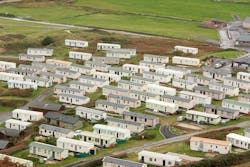This handy Article covers the electrical conductors, equipment, and appurtenances installed “within” or “on” mobile and manufactured homes. A mobile home is a factory-assembled structure or structures that’s transportable in one or more sections, “built” on a permanent chassis, and designed to be used as a dwelling without a permanent foundation connected to necessary utilities that include heating, plumbing, appliances, air-conditioning, lighting “luminaires,” and electrically powered accessories. It also covers “transportable” manufactured homes that are in one or more sections, 8 ft or more in width or 40 ft or more in length in traveling mode, built on a permanent chassis when erected on a site of 320 ft2 or more, and designed to be used as a dwelling unit “with or without” a permanent foundation.
The guidelines within this Article also cover the conductors and electrical equipment that connect mobile and manufactured homes to a “supply” of electricity within a mobile home park “up to” the mobile home service-entrance conductors — the mobile home service equipment for connecting to a 3-wire, 120/240VAC system with a grounded neutral conductor.
Familiarize yourself with these terms!
Following are some unique terms you should know that apply to Art. 500.
Feeder Assembly. The overhead or under-chassis feeder conductors, including the grounding conductor, together with the necessary fittings and equipment or a power-supply cord listed for mobile home use, identified for the delivery of energy from the source of electrical supply to the panelboard within the mobile home.
Mobile Home Accessory Building or Structure. Any awning, cabana, ramada, storage cabinet, carport, fence, windbreak, or porch established for the use of the occupant of the mobile home on a mobile home lot.
Mobile Home Lot. A designated portion of a mobile home park designed for the accommodation of one mobile home and its accessory buildings or structures for the exclusive use of its occupants.
Mobile Home Park. A contiguous parcel of land that is used for the accommodation of occupied mobile homes.
Mobile Home Service Equipment. The equipment containing the disconnecting means, overcurrent protective devices, and receptacles or other means for connecting a mobile home feeder assembly.
Park Electrical Wiring Systems. All of the electrical wiring, luminaires, equipment, and appurtenances related to electrical installations within a mobile home park, including the mobile home service equipment.
Mobile and manufactured home power is supplied by a “feeder”
The mobile home power supply shall be a feeder “assembly” consisting of not more than one listed 50A mobile home power-supply cord or a permanently installed feeder 550.10 (A). If the mobile home has a power-supply cord, it shall be permanently attached to the panelboard or to a junction box permanently connected to the panelboard with the free end terminating in an attachment plug cap, as noted in Sec. 550.10(B). The Art. 100 definition for an attachment plug (plug cap or plug) is a device that, by insertion in a receptacle, establishes a connection between the conductors of the attached flexible cord and the conductors connected permanently to the receptacle. The attachment plug cap shall be 125/250V, 3-pole, 4-wire, grounding type rated at 50A.
The configuration must match Figure 550.10(C). It shall be listed, by itself or as part of a power-supply cord assembly, for the purpose and shall be molded to or installed on the flexible cord so that it is secured tightly to the cord at the point where the cord enters the attachment plug cap. If a right-angle cap is used, the configuration shall be oriented so that the grounding member is farthest from the cord.
Services, feeders, and allowable demand factors
Part 3 (Services and Feeders) of this Article covers everything you need to know about providing power to the entire mobile park. Here are a few facts you should know:
1. Per Sec. 550.30, the secondary (side) of electrical distribution or voltage system for mobile home parks to mobile home lots “shall be” single-phase, 120/240V, nominal.
2. Transformers and secondary panelboards “shall be treated as” services, where the park service exceeds 240V, nominal. This part is important! For testing and exam purposes, always follow instructions from the NEC; never use a minimum volt-ampere (load calculation per lot) less than what is required by Sec. 550.31 (Allowable Demand Factors).
Here’s an example of a typical question you may see on an electrical licensing examination related to this topic:
In a mobile-home park, the computed load for each mobile home is 15,000 VA, and the park will have 25 mobile homes. The service will be a single main, 120/240V service.
The electrical service required for this mobile-home park shall be at least _______ amps.
A. 350
B. 400
C. 1,600
D. 1,700
Step 1. The fastest and most efficient approach to answer this question is to start at the rear of your Code book in the index. Your “keyword” search should start at the letter “M” until you see:
Main Topic: Mobile Home Parks
Sub-Topic: Minimum allowable demand factor, 550.31
Step 2. Confirm the NEC’s minimum “calculated load” requirement.
Aha! Sec. 550.31(1) states that park electrical wiring systems shall be calculated (at 120/240V) on the larger of the following:
(1) 16,000 volt-amperes for each mobile home lot
In the question, they use a computed load of 15,000VA. Since this is below the NEC’s minimum “calculated” load requirement, we must use 16,000VA to meet the minimum load requirement. Always check the NEC’s requirements first — especially for anything that requires a demand factor to be applied. The exam question will typically mislead you; do not be lazy, and make assumptions. This is to test your understanding of when and how to apply the NEC’S calculated “minimum” load requirements.
These exams are designed to test your experience and knowledge on NEC application, navigation, and interpretation. Remember “calculated” electrical service feeder load(s) in a “bulk” quantity (two or more) must have a demand factor applied. For a further explanation, please refer to The Apprentice’s Guide to Service Feeder Calculations.
Step 3. First, we must calculate our GROSS LOAD, Let’s do the math:
(25) mobile homes x 16,000VA = 400,000VA
Step 4. Now apply your demand factor: According to Table 550.31 (Demand Factors for Services and Feeders), we are only required to use 24% of our calculated load.
400,000VA x .24 = 96,000VA
Step 5. Now convert your calculated load (P) power 96,000VA to (I) current or amperes
To perform this calculation, we must use the power wheel formula:
Current I Amps=Power or volt — amperes/V voltage
96,000 ÷ 240 = 400A
The correct answer is B — 400A.
Note: If you used the wrong minimum volt-amperes 15,000 listed in the question (this is also one of your answer choices), be careful. The test creator is testing your knowledge of when to apply the Code guidelines.
Follow my column for more practical how-to articles and tips for applying electric basics concepts in the field. Past columns include Everyday Instructions for Electricians, The Apprentices Guide to Special Equipment, The Apprentice’s Intro Guide to Motors, The Apprentice’s Guide to Service Entrance Cable, and The Apprentice’s Guide to Service Feeder Calculations. For more information on why a structured approach is so important to navigating the NEC and how to put its requirements into practice in real-world settings, read “The NEC for Newbies.”
Harold De Loach, a master electrician and electrical trainer/instructor, is the founder of The Academy of Industrial Arts (www.taia-school.com) in Philadelphia. With more than 30 years of experience in the field, he writes regular exclusive content for the E-Train and can be reached at [email protected].
About the Author
Harold De Loach
De Loach is the Director of Education and Training for the Leaders of Electrical License Preparation courses for Philadelphia and The Lehigh Valley (www.necprepclass.com). He is the founder and Director of The Academy of Industrial Arts L.L.C. (www.taia-school.com), a customized electrician training program that provides entry-level electrician training courses, electrical safety classes and customized electrical construction courses. He is trained by the National Center for Construction Education and Research (NCCER). He is a member of The National Society of Collegiate Scholars, the Independent Association of Electrical Inspectors, the Electrical Association of Philadelphia, and the Better Business Bureau.
His level of knowledge affords him to teach entry, intermediate, and master level electricians. Armed with more than 20 years of experience in the electrical, general construction, and real estate development industry, he offers his students and clients several unique skill sets. He has worked as the Head Craft Instructor and Assistant Director of Education at the Apprenticeship Training Center (affectionately known as The ABC School) in Harleysville Pennsylvania for Associated Builders and Contractors (The South-Eastern Pa. Chapter). Prior to Joining ABC, he directed a work-readiness (Re-Entry) Construction Technology program within The Philadelphia Prison System and as an Electrical Technician Program instructor at Kaplan Career Institute (Formerly Thompson institute) in Center City Philadelphia and Franklin Mills. He is available for consultation, private tutoring, speaking engagements, or strategic partnerships that can bolster the number of new electricians entering the industry.

